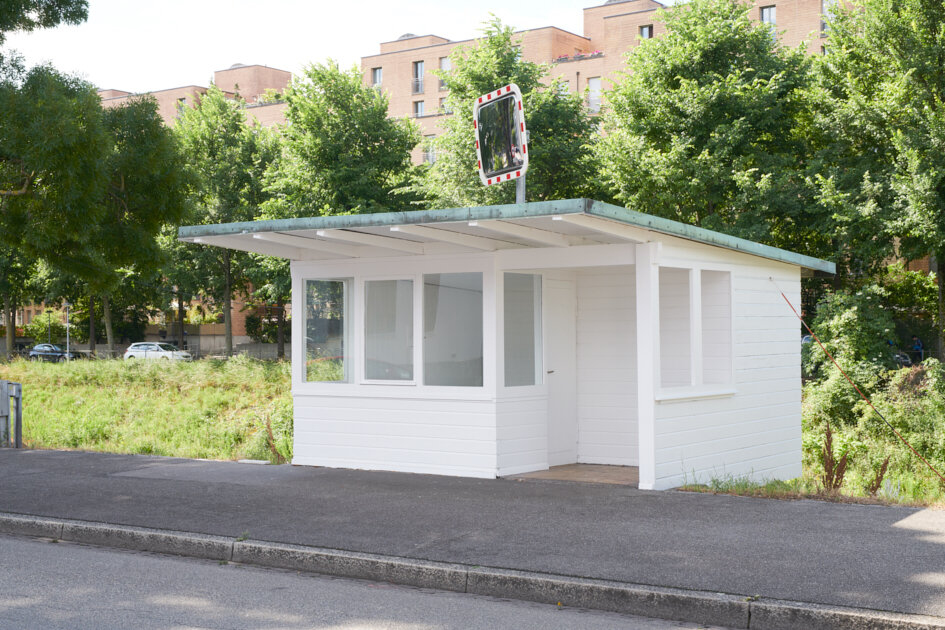Mischa Düblin (*1973, Basel) und Fabian Unold (*1977, Zürich) arbeiten seit 2004 unter dem Namen «Thylacine» (engl. Beutelwolf) als Künstlerduo zusammen und realisieren orts- und kontextspezifische Arbeiten. Ohne sich auf ein Medium oder eine Form festlegen zu wollen, ergibt sich durch das situationsbedingte Arbeiten des Duos eine Tendenz zum Performativen und zur Installation. Auch das Spiel mit dem Publikum oder der Miteinbezug von weiteren Schauspielern oder Performerinnen sind möglich.
Soziale Gefüge und ökonomische Mechanismen stehen im Zentrum von Thylacines Interesse. Ihre Kunst will nicht in den White Cube, sie funktioniert nicht in und für sich, sondern immer in Beziehung zur realen Welt. Kritisch, politisch und mit einer guten Prise Humor widmen sich die beiden bestimmten Berufsgruppen, untersuchen gesellschaftliche Machtstrukturen und machen sich diese Begebenheiten auch gerne mal zu eigen. Dabei ist ihre Kunst zwar prägnant und konsequent umgesetzt, in der Aussage lässt das Duo jedoch stets absichtlich Raum für Interpretation. Aus einer inhaltlichen aber auch konkret physischen Aneignung resultiert ein authentisches und überzeugendes Involviertsein der Künstler. So setzen sie sich etwa für «Schweigeminute» (2007) eine ganze Stunde dem direkten Strahl einer Schneemaschine aus oder sie pinkeln sich für eine Performance zum Thema Angst gleichzeitig in die Hosen («Stille Wasser», 2008).
Thylacines Projekte, Performances und Installationen gibt es immer nur einmal. Im Artachment sind die beiden Künstler allerdings bereits zum zweiten Mal zu Gast: Vor zehn Jahren haben Mischa Düblin und Fabian Unold auf Einladung von Raphael Bottazzini das allererste Projekt in dem kleinen Häuschen im Kleinhüninger Hafen realisiert. Nach genauem Beobachten der Situation vor Ort schenkte das Künstlerduo diesem damals noch sehr verlassenen und oft von Vandalen heimgesuchten Ort einen Bewohner. Sie installierten eine menschengrosse Puppe so im Häuschen, als würde ein im Raum sitzender Mann durch das Fenster an der Rückwand Fische angeln. Durch seinen neuen Bewohner wurde der Ort plötzlich wohnlich, wirkte eingerichtet und erhielt eine Verbindung zur Aussenwelt. Die Situation war so subtil (es gab keine Vernissage und keinen Hinweis auf das Kunstprojekt) und gleichzeitig derart realistisch, dass Passanten darauf aufmerksam wurden und die Polizei anriefen.
Heute, zehn Jahre später, sind Thylacine wieder da und stellen zeitgleich mit Roman Signer aus. Mit der neu entwickelten Arbeit «Schein» (2018) thematisieren die beiden das Aufeinandertreffen mit dem renommierten Schweizer Künstler, aber auch den 10-jährigen Geburtstag des Kunstraums: Dazu hängen sie einen Theaterscheinwerfer in einen Baum neben dem Kunstraum und versehen ihn mit einer Zeitschaltuhr, welche das An- und Ausschalten des Lichts in einem vordefinierten Rhythmus regelt. Ein Scheinwerferlicht bestrahlt normalerweise eine Attraktion, ein Star tritt darin auf, etwas Wichtiges erhält eine Bühne ... Doch das von Mischa Düblin und Fabian Unold installierte Spotlight schiesst (scheinbar) am Ziel vorbei. Der Lichtkegel beleuchtet weder das Jubiläum feiernde Häuschen, noch die Installation von Roman Signer, noch das Publikum. Die einzige Verbindung zum Haus bildet ein Stromkabel. Ansonsten bleibt Thylacines künstlerischer Eingriff im Grunde immateriell. «Schein» beleuchtet eine leer gebliebene Bühne, einen Unort, eine Lücke und wird damit zum eigenartigen und erfrischend nicht eindeutigen Hinweis.
Mischa Düblin (b. 1973, Basel) and Fabian Unold (b. 1977, Zurich) have been working together since 2004. The artistic duo realises site- and context-specific works under the name Thylacine. Not limiting themselves to one medium or form, the duo’s situation-specific approach tends towards installations and the performative. Games with the audience or the involvement of other performers open up further possibilities.
Social structures and economic mechanisms are at the heart of Thylacine’s interest. Their art doesn’t aim for the white cube, it doesn’t function intrinsically or by itself, but invariably in relation to the real world. Critically, politically, and always with a good dose of humour, they examine balances of power, and make these events their own. While their art is implemented concisely and consistently, it deliberately leaves room for interpretation. The authentic and persuasive involvement of the two artists results from a content-related but also concretely physical appropriation. In this vein, they expose themselves to the direct jet of a snow machine for the 2007 work Schweigeminute (A Minute’s Silence), or they simultaneously pee their pants for the 2008 performance Stille Wasser (Still Waters) on the subject of fear.
Thylacine’s projects, performances and installations only ever happen once, but they have appeared twice at Artachment. In 2008, Mischa and Fabian were invited by Raphael Bottazzini to realise the very first project ever carried out in the former customs house at Kleinhüningen harbour. After careful observation of the site, the duo gave the space, which was at the time abandoned and frequently visited by vandals, a resident: they installed a life-sized puppet to make it look like someone sitting in the space was angling for fish through the window in the back wall. Through its new inhabitant, the space suddenly became accommodating, and a connection to the outside world was established. The situation was subtle (there was no opening and no publicity) and at the same time so realistic that passers-by who spotted the figure inside called the police.
Thylacine returned to Artachment in 2018 to exhibit in dialogue with Roman Signer. For their newly developed work Schein (Appearance), marking the 10th anniversary of the art space, they suspended a theatre spotlight from a tree next to the building and equipped it with a timer, which switched the light on and off in a predefined rhythm. A spotlight usually illuminates an attraction; a star performs in it, something important is given a stage. But the spotlight installed by Thylacine apparently misses its mark. The light beam illuminates neither the house celebrating its anniversary, Roman Signer’s installation, nor the public. The only connection to the house is the power cable. Other than that, the artistic intervention remains essentially immaterial. Schein illuminates a stage that remains empty, a non-place, a gap, and thus becomes a strange and refreshingly nebulous presence.












